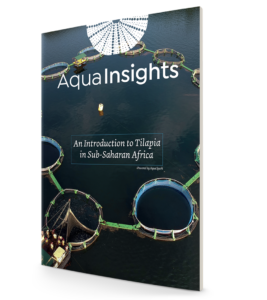Farmed tilapia offers a scalable, sustainable and affordable means of feeding the region’s growing population, according to firm’s analysis

Aqua-Spark, the first investment fund focused on sustainable aquaculture, has released its inaugural Aqua Insights Report, the first in a series of free industry reports. The series is designed for a broad range of stakeholders, with the aim of “galvanizing more investment into the development of a sustainable aquaculture industry.”
“With this report, we intend to openly and freely showcase the insights we’ve gathered over the last 10 years to help shape the development of a sustainable aquaculture industry and catalyze investment towards scaling,” said Mike Velings and Amy Novogratz, co-founders of Aqua-Spark.
This edition specifically focuses on farmed Nile tilapia (Oreochromis niloticus) in sub-Saharan Africa – a timely topic since Aqua-Spark Africa, a new branch of the fund, launches in late 2021. The 92-page report looks in-depth at the current landscape – an overview of tilapia production, the producers involved, the various segments of the supply chain – as well as sector challenges and investment opportunities. It also discusses why and how farmed tilapia will play a critical role in ensuring the region’s future food security.
“Sub-Saharan Africa is where much of the world’s future population growth will happen and where the food challenge will become most severe,” said Willem van der Pijl, editor-in-chief of Aqua Insights. “Raising awareness around the role that aquaculture can play in solving this challenge in a sustainable way is pivotal.”
As highlighted in the report, the region’s population will balloon from 1 billion in 2021 to 2 billion by 2050. As a result, the demand for fish will exceed the 10 million metric tons (MT) today and by 2050 could reach between 16 to 29 million MT per year. Wild catch can’t be increased due to overexploitation, meaning that aquaculture production must accelerate to meet the growing need for protein. According to Aqua-Spark’s analysis, tilapia could be the best solution, as it’s scalable, healthy, sustainable and affordable.
“We believe that reliably meeting the world’s growing demand for protein while simultaneously sustaining our environment will require a radical transformation of global aquaculture,” said Velings and Novogratz. “This type of shift calls for a large-scale collaborative effort of diverse stakeholders and investors committed to supporting innovation and long-term growth.”
Download the full report here.
Now that you've reached the end of the article ...
… please consider supporting GSA’s mission to advance responsible seafood practices through education, advocacy and third-party assurances. The Advocate aims to document the evolution of responsible seafood practices and share the expansive knowledge of our vast network of contributors.
By becoming a Global Seafood Alliance member, you’re ensuring that all of the pre-competitive work we do through member benefits, resources and events can continue. Individual membership costs just $50 a year.
Not a GSA member? Join us.



